Video Transcription
Water resistance is a fickle thing. People will often mistake water-resistant for waterproof, and these are not the same. A watch should never be considered waterproof, rather water-resistant. For starters, a depth rating is really just another way to represent a measure of pressure. It’s much easier to convey a watch’s rating as 100 meters then it’s more technical ratings of 10 atmosphere or 10 bars. To put it another way, depth ratings are really just a functional representation of the lesser known pressure ratings.
You will often see “Waterproof up to 300 meters” and that in and of itself is a little misleading. Waterproof definitely sounds better from a marketing standpoint but isn’t the most accurate representation of a watch’s ability. Also, water-resistant ratings are measured with static pressure. This means there’s a very controlled environment in which a watch is being tested, and again, probably not the most accurate representation of a real-world scenario.
The Ratings
Now let’s take a look at some of the more common water-resistant ratings we see and what they actually mean.
30 Meters
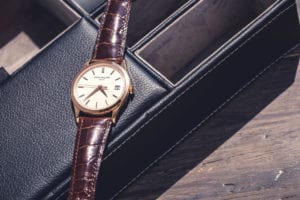
30 meters is often seen on dress watches like this Patek. They lack a screw down crown and should be treated with the utmost care around water of any kind. You would be fine if you wash your hands or it was raining, but that’s where we would draw the line.
50 Meters
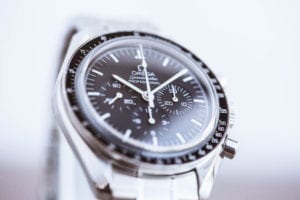
50 meters offers a little more water resistance and is common on pilot watches and other sport watches like this OMEGA. Even with the increased water resistance we would still recommend similar precautions. And even though 30 meters and 50 meters sounds deep, absolutely no swimming. Because of all of the uncontrollable variables of being in the water you could easily, and unknowingly force water into the case.
100 Meters
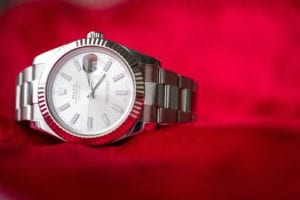
Next up, 100 meters. We are now in the territory of watches with screw-down crowns and a completely sealed case. You would be okay to take a watch like this Datejust swimming. Some watches that have 100-meter water-resistant rating lack a screw down crown or screw down pushers. Because these cases are not completely sealed, we would recommend never taking these in water. We recommend removing watches prior to showering. Soap and steam are never friends of gaskets, and it’s always better to be safe than sorry.
300 Meters
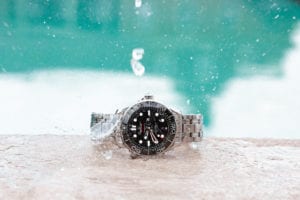
300 meters. This is the standard rating for a dive watch. Think watches like this Submariner or the OMEGA Seamaster. This watch is suitable for day-to-day activities, as well as most recreational scuba diving. You can see how the screw down crown also has additional gaskets. And if you are using a watch for diving it is recommended to have the gaskets and seals checked regularly.
300+ Meters
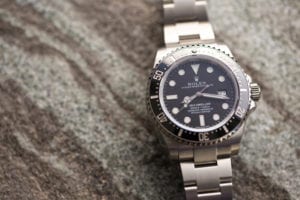
300 meters and beyond. Watches like the Planet Ocean and the Sea-Dweller have greater depth ratings and are often designed for saturation diving. While most people will never go saturation diving or need the 1,220-meter rating of the Sea-Dweller, it’s pretty impressive to see what can be manufactured. In a similar vein, does anyone need the 500 plus horsepower of a Porsche Turbo? No, but it’s definitely a statement to human ingenuity and precision engineering.
Be Smart & Be Safe
Water resistance versus waterproof is one of those discussions that is never-ending. There are countless opinions on what you should and should not do. Ultimately being smart with your watch and using the depth rating as a guide can keep your watch safe and free from water damage. Let us know if you have any questions about the water resistance of your watch and thanks for watching.
Get More Articles Like This in Your Inbox
We're constantly creating great content like this. So, why not get it delivered directly to your inbox? By subscribing you agree to our Privacy Policy but you can unsubscribe at any time.





